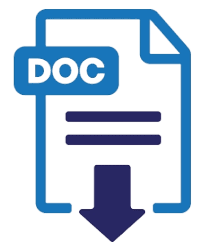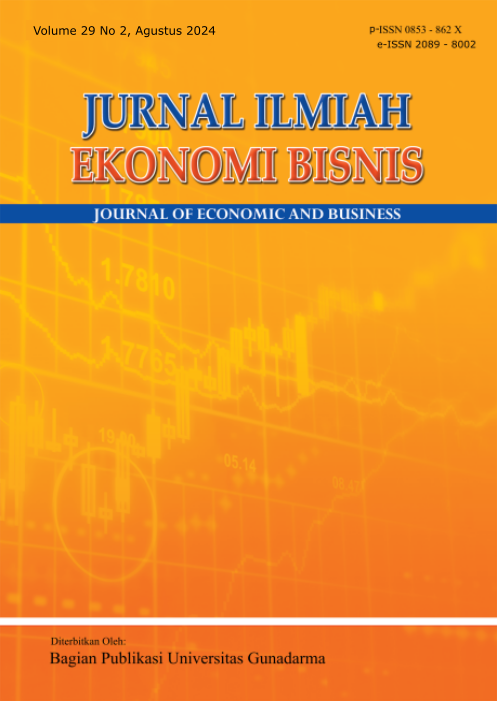PENGARUH PEMANFAATAN INTERNET UNTUK PROMOSI DAN PENJUALAN TERHADAP PENDAPATAN PEMILIK USAHA
University of Indonesia
Indonesia
University of Indonesia
Indonesia
Abstract
Penelitian ini menganalisis pengaruh internet terhadap pendapatan pada pemilik usaha di Indonesia. Penelitian ini menggunakan data pooled cross section yaitu SAKERNAS Agustus 2018-2021. Model yang digunakan adalah Instrumental Variabel (IV) dengan Two-Stage Least Square (2SLS). Hasil estimasi first stage menunjukkan bahwa jumlah Base Transceiver Station (BTS) per Kabupaten berpengaruh positif pada tingkat pemakaian internet. Selanjutnya hasil estimasi second stage menunjukkan bahwa pemakaian internet berpengaruh positif pada pendapatan pemilik usaha. Terdapat perbedaan pemakaian internet (promosi, komunikasi, transaksi, penjualan via email dan sosial media, serta penjualan via web/marketplace) terhadap pendapatan pemilik usaha. Selain itu, ditemukan bahwa transmisi internet lebih besar pengaruhnya untuk kegiatan usaha pada promosi dan transaksi daripada komunikasi.
Keywords
References
Abidi, N., El Herradi, M., & Sakha, S. (2023). Digitalization and resilience during the COVID-19 pandemic. Telecommunications Policy, 47(4), 1-19. doi.org:10.1016/j.telpol.2023.102522.
Aditina, N., & Sugiharti, L. (2019). The effect of internet technology on women’s decision to work at home. Jurnal Economia, 15(2), 209–220. doi.org:10.21831/economia.v15i2.24694.
Alsolamy, M. (2022). Enhancing adaptation of digital entrepreneurship to consumers’ online purchasing in the COVID-19 pandemic era. Technology Analysis and Strategic Management, 1–14. doi.org:10.1080/09537325.2022.2110057.
Badan Pusat Statistik. (2021). Statistik karakteristik usaha 2021. Retrieved from: https://www.bps.go.id/publication/2021/12/17/4e90dd21d3bf177e497a92c7/statistik-karakteristik-usaha-2021.html.
Badan Pusat Statistik. (2022). Statistik karakteristik usaha 2022. Retrieved from: https://www.bps.go.id/publication/2022/12/19/3220c5de821adde8bd6c7f87/statistik-karakteristik-usaha-2022-.html.
Badan Pusat Statistik. (2022). Statistik telekomunikasi Indonesia 2021. Retrieved from: https://www.bps.go.id/publication/2022/09/07/bcc820e694c537ed3ec131b9/statistik-telekomunikasi-indonesia-2021.html.
Badan Pusat Statistik. (2022). Statistik pendapatan Agustus 2022. Retrieved from:https://www.bps.go.id/publication/2022/12/07/694d7d6260c74ae507313819/statistik-pendapatan-agustus-2022.html.
Badan Pusat Statistik. (2022). Statistik e-commerce 2022. https://www.bps.go.id/publication/2022/12/19/d215899e13b89e516caa7a44/statistik-e-commerce-2022.html
Badan Pusat Statistik. (2022). Indeks pembangunan teknologi informasi dan komunikasi 2021. https://www.bps.go.id/publication/2022/09/30/5fe4f0dbccd96d07098c78d3/indeks-pembangunan-teknologi-informasi-dan-komunikasi-2021
Badan Pusat Statistik. (2022). Agustus 2022: Tingkat pengangguran terbuka (TPT) sebesar 5,86 Persen Dan Rata-Rata Upah Buruh Sebesar 3,07 Juta Rupiah Per Bulan. https://www.bps.go.id/pressrelease/2022/11/07/1916/agustus-2022--tingkat-pengangguran-terbuka--tpt--sebesar-5-86-persen-dan-rata-rata-upah-buruh-sebesar-3-07-juta-rupiah-per-bulan.
Badan Pusat Statistik. (2022). Keadaan angkatan kerja di Indonesia Agustus 2022. https://www.bps.go.id/publication/2022/12/07/a64afccf38fbf6deb81a5dc0/keadaan-angkatan-kerja-di-indonesia-agustus-2022.html
Badan Pusat Statistik. (2022). Indeks pembangunan teknologi informasi dan komunikasi 2021. https://www.bps.go.id/id/publication/2022/09/30/5fe4f0dbccd96d07098c78d3/indeks-pembangunan-teknologi-informasi-dan-komunikasi-2021.html
Badan Pusat Statistik. (2022). Statistik pendapatan eCommerce 2022. https://www.bps.go.id/id/publication/2022/12/19/d215899e13b89e516caa7a44/statistik-e-commerce-2022.html
Badan Pusat Statistik. (2022). Statistik karakteristik usaha 2022. https://www.bps.go.id/id/publication/2022/12/19/3220c5de821adde8bd6c7f87/statistik-karakteristik-usaha-2022.html
Badan Pusat Statistik Indonesia. (2023). Profil industri mikro dan kecil 2021. https://www.bps.go.id/id/publication/2023/04/18/228f9c6242ef5a06b2dc740e/profil-industri-mikro-dan-kecil-2021.html
Badan Pusat Statistik. (2023). Proporsi lapangan kerja informal menurut jenis kelamin, 2018-2020. https://www.bps.go.id/id/statistics-table/2/MjE1NSMy/proporsi-lapangan-kerja-informal-menurut-jenis-kelamin.html
Badan Pusat Statistik. (2023). Sumbangan pendapatan perempuan (Persen). https://www.bps.go.id/id/statistics-table/2/NDY3IzI=/sumbangan-pendapatan-perempuan--persen-.html
Barnett, W. A., Hu, M., & Wang, X. (2019). Technological forecasting & social change does the utilization of information communication technology promote entrepreneurship: Evidence from rural China. Technological Forecasting & Social Change, 141(January), 12–21. doi.org:10.1016/j.techfore.2019.01.007.
Bauer, J. M. (2018). The Internet and income inequality: Socio-economic challenges in a hyperconnected society. Telecommunications Policy, 42(4), 333–343. doi.org:10.1016/j.telpol.2017.05.009.
Butler, P. J., & Peppard, J. (1998). Consumer purchasing on the Internet: European Management Journal, 16(5), 600–610. doi.org:10.1016/s0263-2373(98)00036-x.
Castellacci, F., & Tveito, V. (2018). Internet use and well-being: A survey and a theoretical framework. Research Policy, 47(1), 308–325. doi.org:10.1016/j.respol.2017.11.007.
Fang, Z., Razzaq, A., Mohsin, M., & Irfan, M. (2022). Technology in Society Spatial spillovers and threshold effects of internet development and entrepreneurship on green innovation efficiency in China. Technology in Society, 68(September 2021), 101844. doi.org:10.1016/j.techsoc.2021.101844.
Feldman, D. C., & Klaas, B. S. (2002). Internet job hunting: A field study of applicant experiences with on-line recruiting. Human Resource Management, 41(2), 175–192. doi.org:10.1002/hrm.10030.
Gustina, L., Utami, D., & Wicaksono, P. (2020). The role of cognitive skills, non-cognitive skills, and internet use on entrepreneurs’ success in Indonesia. Jurnal Economia, 16(1), 130–142. doi.org:10.21831/economia.v16i1.30414.
Hashim, J. (2015.). Information communication technology (ICT) adoption among SME owners in Malaysia. International Journal of Business and Information, 2, 221–240.
Kharisma, B. (2022). Surfing alone? The Internet and social capital: Evidence from Indonesia. Journal of Economic Structures, 11(8), 1-17. doi.org:10.1186/s40008-022-00267-7.
Kementerian Komunikasi dan Informatika Republik Indonesia (2023). Laporan tahunan Kementerian Kominfo Tahun 2022. https://www.kominfo.go.id/content/detail/49962/laporan-tahunan-kementerian-kominfo-tahun-2022/0/laporan_tahunan.
Kusumawardhani, N., Falentina, A., Bachtiar, P., & Indrio, V. T. (2022a). Internet usage among women‐led micro and small enterprises and household membersʼ use of the internet at home: Evidence from Indonesia during the COVID‐19 pandemic. Asia & the Pacific Policy Studies, 9(3), 370-393. doi.org/10.1002/app5.366.
Kusumawardhani, N. (2022b). Women and Digitalization: The promises and challenges of internet use in Indonesian labor market internet and female labor market outcomes. The SMERU Research Institute.
Kusumawardhani, N., Pramana, R., Saputri, N. S., & Suryadarma, D. (2023). Heterogeneous impact of internet availability on female labor market outcomes in an emerging economy: Evidence from Indonesia. World Development, 164(2023), 1-19. doi.org:10.1016/j.worlddev.2022.106182.
Li, J., Wu, Y., & Xiao, J. J. (2020). The impact of digital finance on household consumption: Evidence from China. Economic Modelling, 86(July 2019), 317–326. doi.org:10.1016/j.econmod.2019.09.027.
Ma, W., Nie, P., Zhang, P. & Renwick, A. (2020). Impact of Internet use on economic well-being of rural households: Evidence from China. Review of Development Economics, 24(2), 503-523. doi.org:10.1111/rode.12645.
Ma, X. (2022). Internet use and gender wage gap: evidence from China. Journal for Labour Market Research, 56(15), 1-17. doi.org:10.1186/s12651-022-00320-9.
Mincer, J. (1958). Investment in human capital and personal income distribution. Journal of Political Economy, 66(4), 281–302.doi.org:10.1086/258055.
Omar, S., & Morales, C. (2021). Innovation as recovery strategy for SMEs in emerging economies during the COVID-19 pandemic. Research in International Business and Finance, 57(2021), 1-9. doi.org:10.1016/j.ribaf.2021.101396.
Pindyck, R. S., & Rubinfeld D. L. (2018). Microeconomics (9th Global Edition). Harlow: Pearson Education Limited.
Rosalin, Y. (2022). Dampak internet terhadap penghasilan perempuan pekerja informal di Indonesia (Master’s thesis). Fakultas Ekonomi dan Bisnis, Universitas Indonesia. Retrieved from: https://lontar.ui.ac.id/detail?id=20520307&lokasi=lokal.
Tan, Y., & Li, X. (2022). The impact of internet on entrepreneurship. International Review of Economics and Finance, 77(April 2020), 135–142. doi.org:10.1016/j.iref.2021.09.016
Todaro, M. P., & Smith, S. C. (2012). Economic development (11th ed., 801 p.). Harlow: Addison-Wesley, Pearson.
Trinugroho, I., Pamungkas, P., Wiwoho, J., Damayanti, S. M., & Pramono, T. B. (2022). Adoption of digital technologies for micro and small business in Indonesia. Finance Research Letters, 45(March 2022), 1-7. doi.org:10.1016/j.frl.2021.102156
Wang, J., Hu, Y., & Xiong, J. (2024). The internet use, social networks, and entrepreneurship: evidence from China. Technology Analysis and Strategic Management, 36(1), 122–136. doi.org:10.1080/09537325.2022.2026317.
Yuldinawati, L., van Deursen, A. J. A. M., & van Dijk, J. A. G. M. (2018). Exploring the Internet Access of Indonesian SME Entrepreneurs. International Journal of Business, 23(3), 235-247.
Zhou, X., Cui, Y., & Zhang, S. (2020). Internet use and rural residents’ income growth. China Agricultural Economic Review, 12(2), 315–327. doi.org:10.1108/CAER-06-2019-0094.


